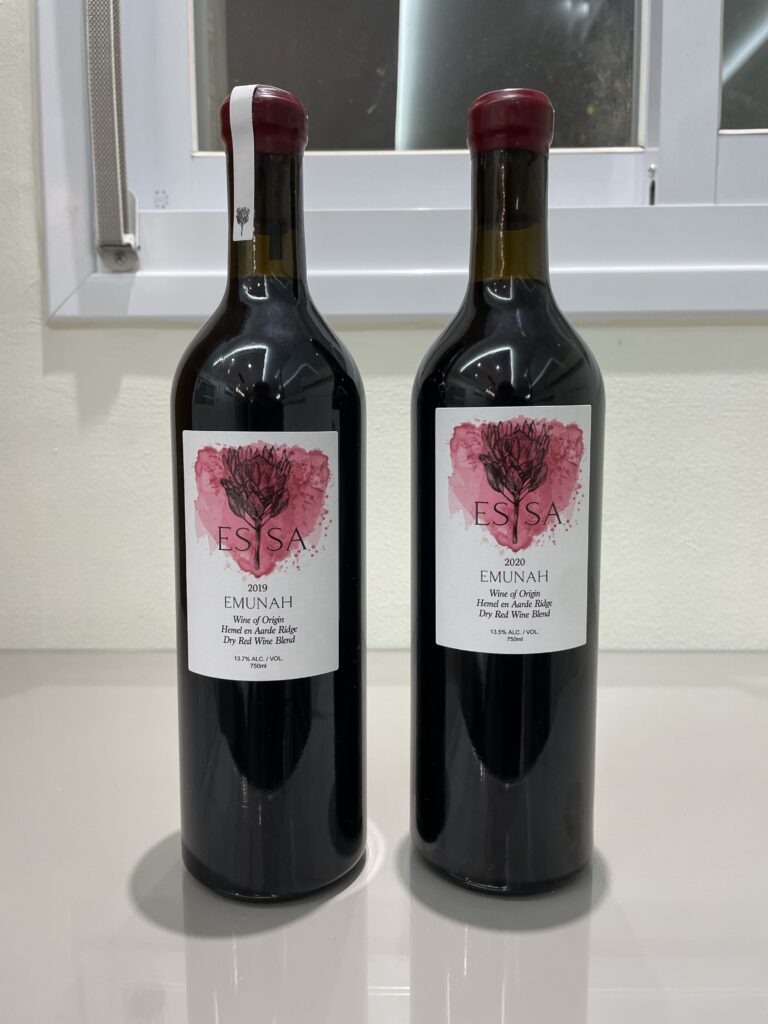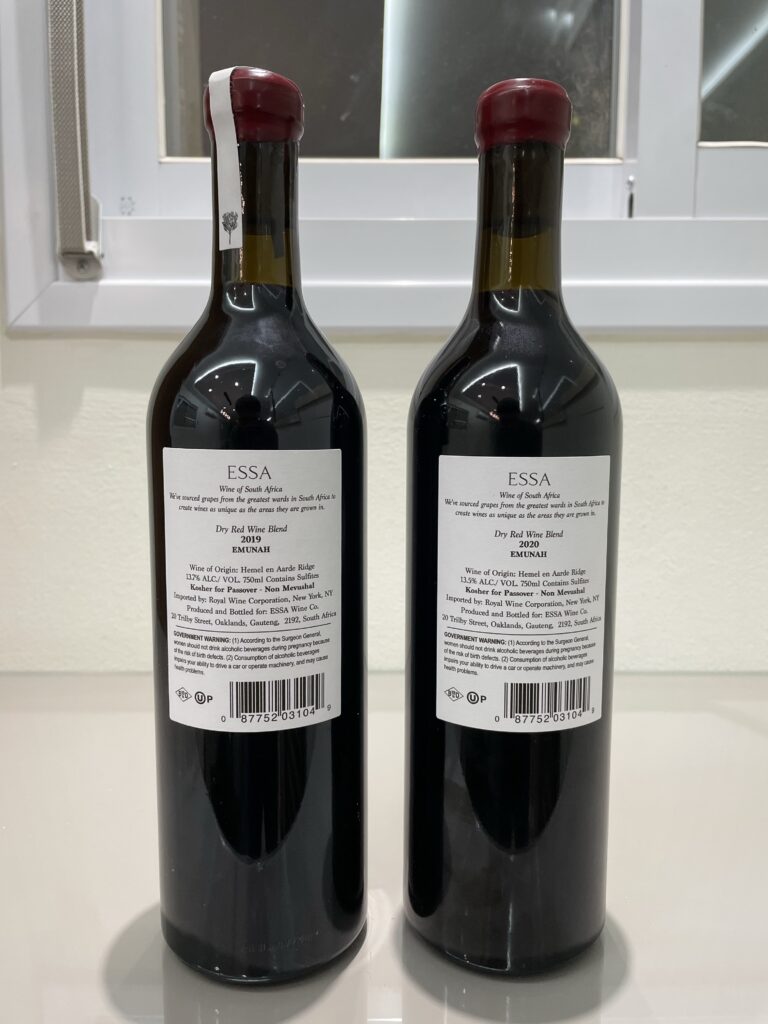
Most winemakers do not care what wine writers have to say about their wines (unless it’s positive of course). Nor should they. As I have noted numerous times, what makes my palate any better than theirs – or anyone else’s for that matter. But every once in a very long while I get sent wines by winemakers who actually want to hear what I think about their wines. Usually these are winemakers whom I have some sort of relationship with. I try to disclose that, so everything is transparent with the reader. This case is a little unique. I was sent two bottles by winemaker Josh Rynderman. I have written about Josh in passing before. His initial claim to fame is that he is the assistant winemaker to Benyomin Cantz at Four Gates. Besides that prestigious and enviable position, he also produces his own wines and is the winemaker both in California under the Kos Yeshuos label and, more importantly for this article, in South Africa under the Essa label. (I wonder if his next winery will be called UvShem HaShem Ekra….) I really have only met Josh once when he was visiting Israel a couple of years ago. So, it’s not like we have a deep relationship or anything, and so I really appreciate the effort he spent in getting me a couple of his wines to taste. I promised I would give full notes, and they are here as well. As these wines are NOT imported to Israel (though I do hope that will change) I figured I would invite a couple of friends who might appreciate tasting Josh’s wines to join with me. [I do have to say that it’s nice that I can get together on a Friday afternoon with people who live close by and taste through a number of wines – no muss, no fuss. When I first made Aliyah, this was a pipe dream. It took over 20 years, but here we are and it was well worth the wait.] Each of these friends contributed a couple of unique bottles, and in the end we ended up with a nice tasting, where all except for one of these bottles are unavailable at all in Israel (and quite frankly, hard to find in the US as well). All of this was reason enough to dedicate a full post and so here are my notes on these wines.
2020 Binah, Gruner Veltliner, Lehigh Valley, Pennsylvania – Kosher Gruners are few and far in between – and that’s a shame. I have liked just about all of the kosher Gruners I have tasted – and this is no exception. On the nose, you don’t get much, maybe some citrus and some floral notes. In the mouth though, it’s a different story with a mix of cut grass, hay, lime, and apple. The acidity here is truly excellent and balances out the fruit. On the finish more lime, some apple, and some nice mineral. Nice wine! 91
2021 J. de Villebois, Sancerre, Cuvee Terroir, Silex – No change since my last tasting. Really nice. This would be the wine to check if you ever wanted to understand what I mean when I use flint as a descriptor. Good stuff.. 91+
2019 Binah, Chambourcin, Pennsylvania – I’m not sure that I have ever had another Chambourcin – so I have no point of reference. Ultimately, while I applaud the winemaker’s desire to produce some unique kosher wines, I can’t say that I am a fan of this one. Not much of a nose on this wine other than some vague ripe black fruit. The mouth is just stewed and ripe with some nice acid – but that’s about it. It was odd. The mid-palate was oddly hollow, but the finish was over the top ripe with almost candied blackberry. Maybe this was a bad bottle – or this simply was just not for me. 75
2021 Eola Hills Wine Cellars Pinot Noir, Willamette Valley, Oregon – This is a wine that I was very excited to taste, as there are so few kosher Willamette PN’s available. Going into this, I made sure to keep my expectations in check, as while Willamette produces some of the world’s best Pinot Noir, the style is usually far from Old World Burgundy. This proved to be smart, as really, had I gone into this expecting a Premier Crus Gevrey-Chambertin, I would have been sorely disappointed. This is a VERY New World expression of Pinot. On the nose, you have crazy ripe or even candied fruit, followed by notes of chocolate and cedar. In the mouth, the wine is much heavier than I am used too and quite frankly drinks a bit hot – and unsurprisingly, the wine comes in at a whopping 14.4%! In the mouth, with a lot of chocolate and very ripe fruit. I couldn’t sit with this wine for an extended amount of time (I had about an hour with it), so I don’t know if it improves – but for me, this wine lacks balance and really is bit too over the top – though it does show nice concentration and, as I said, does have the potential to improve. For now, its’s an 88.
2019 Castellare di Castellina, Chianti Clasicco – This is a wine I have tasted before but never posted my notes. Right off the bat, it is important to note how there is no one style for Chianti Classico. While we in the kosher world are basically used to getting the Terra di Seta and pretty much nothing else in terms of Chianti Classico (The Cantina Guilliana wines are Chianti, not Chianti Classico) The Catellare wines are very different from TdS, making comparing them hard if not impossible, and so I won’t bother. I will just note that this wine presents leaner than the TdS wines. But don’t let that leanness fool you. While perhaps not as plush as the TdS wines, this wine is perhaps more elegant. On the nose you get wonderful dark red fruit and toasted herbs, followed by some smoke. In the mouth, you get some very nice dark red cherry, raspberry, and smoke with some really great mineral notes, with medium plus acidity and nice silky tannin that is nicely integrated. Note though, this wine took a good hour to open fully and really show – so give it the time it needs! On the finish, there is some nice earth and more toasted herb – primarily rosemary and some sage with more red fruit, tobacco, and smoke. Overall this was a super enjoyable Chianti Classico. Only problem here is perhaps the price. In Israel it is between 2-3 times the price of the TdS CC. Still, it’s nice to have the variety in the market. 92
2020 Terra di Seta, Chianti Classico – Speaking of Terra di Seta, here we are. When we tasted, this wine had just been released and was fresh off the boat, and we decided to taste it next to the Castellare. The crazy thing is, as I am talking about TdS wines above, this is the most atypical Terra di Seta Chianti Classico that I have tasted. Usually there is much more of a mushroom profile to the TdS wines – and here I got none of it. That aside, the wine presented well, though super young. On the nose, really nice bright but deep red fruit followed by some greener herb notes and nice earth. In the mouth, the wine basically follows the nose with some nice ripe raspberry good toasted herb and rich earth. The wine is medium bodied with very nice acid and some nice chewy tannin. The wine shows nicest on the finish with more red fruit followed by a ton of herb and some smoked meat and of course more earth. The herb is really excellent and works harmoniously with the meaty earthiness. Really tasty. So while a little light on the mushroom, still overall this sticks to the TdS playbook and is a much more of a full flavored dense wine than the Castellare – though not as elegant. On the plus side – Castellare really can’t compete here on the price. 91


2019 ESSA, Emunah, Hemel en Aarde Ridge – Emunah is winemaker Josh Rynderman’s Bordelais blend – in this instance 75% Cabernet Sauvignon and 25% Cabernet Franc. Now while only 25% Cab Franc, those CF notes come through loud and clear both on the nose and in the mouth. On the nose, ripe black and red fruit, followed by some really nice clear green notes that are both vegetal and herb, with nice moist earth in the background. In the mouth, you basically have a repeat of the nose with ripe blackberry and raspberry, followed by excellent herb and some great, almost sweet vegetal notes. There is a wonderful core of tannin and very nice acid to keep all of this in check. On the finish, you get yet more of those green notes with some tobacco and some espresso as well. This wine was really well made and is lovely. I do hope that I have an opportunity to get my hands on more of it. 92+
2020 ESSA, Emunah, Hemel en Aarde Ridge – For the 2020, Josh doubled down on the Cabernet Franc, with it now being 75% of the blend with the remaining 25% Merlot. Now let me start by saying there were some SERIOUS reductive notes when we opened this wine. I asked Josh about this, and yes, there are reports of some bottles presenting this way. Others from the same bottling batches present fine – so it’s a bit weird. Luckily this totally blows off with time – so don’t toss the wine if you come across one of these! The wine is fine – just let it air out. On the nose, the wine presents more red than the previous vintage, followed by nice mounds of rich earth. In the mouth, the green notes are more assertive, primarily with green pepper followed by some nice earth and mushroom and then the red fruit – more raspberry than anything else. I stayed with this botte over Shabbos, and I can say it vastly improved, becoming richer with some black fruit and nice herb added to the mix. I’m not sure if this is typical or just a further reaction to the reduction issue – again I would love to have another bottle to compare to. In any event, with time, the wine really does come into its own. The finish is really nice with earth, mushrooms, herb, and some nice cigar box. Really very nice if a touch behind the 2019. 90.5
My thanks to Josh Rynderman for sharing his wines with me as well as to my friends S.H and A.M., who hosted and contributed the other wines.